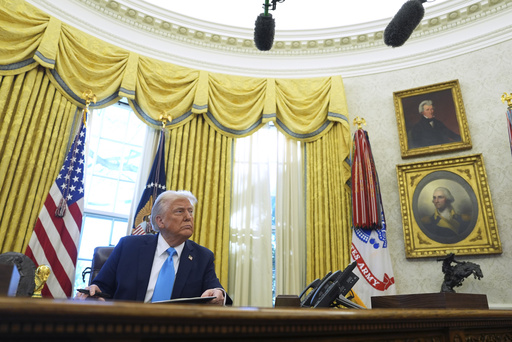President Donald Trump is looking to significantly reduce the operations of the U.S. Education Department, instructing his administration to cut spending while encouraging staff to resign. However, his intention to abolish the department faces a challenge—much of its funding and existence is determined by Congress.
A White House executive order that is currently in the works seems to acknowledge the limitations of presidential authority. This anticipated order would instruct the head of the Education Department to begin the process of shutting down, while simultaneously pushing Congress to enact legislation to formally disband the agency, according to insiders aware of the situation.
Although Trump has not finalized this order, he made a remark at a recent White House press briefing about Linda McMahon, his nominee for education secretary, playfully suggesting she should aim to eliminate her own position.
During his campaign, Trump committed to dismantling the Education Department, alleging that it has been overtaken by “radicals, zealots, and Marxists.” Since the agency’s inception nearly fifty years ago, there have been intermittent attempts by conservatives to eliminate it, arguing that it squanders taxpayer funds and intrudes on local education choices.
Trump is anticipated to give his education secretary a timeline to draft a plan for the agency’s dissolution; nonetheless, even those aligned with him doubt how feasible this endeavor is without support from Congress. Many essential programs, such as Title I funding for low-income schools and federal student loans, are mandated by federal law.
This challenge was evident during Trump’s first term when his education secretary aimed for budget reductions but was consistently met with increased funding from Congress instead.
Compounding the dilemma, Trump’s own policy pursuits have added new responsibilities for the department. He has rolled out initiatives to encourage “patriotic” education and to challenge schools that offer controversial courses on race and gender. The agency is also investigating colleges following Trump’s directive to address antisemitism on campus.
The possible reductions that Trump can implement might only affect a small fraction of the department’s overall budget, which stands at around $79 billion annually, according to a source familiar with the administration’s plan. This information was shared with anonymity because they were not permitted to speak publicly about the strategy.
Trump’s ability to garner congressional support for his initiatives would serve as a significant test of his influence. Some Republican lawmakers have cast doubt on whether there is enough public backing to eliminate the department or to cut its critical programs that benefit both Republican and Democratic states.
In 2023, the House discussed an amendment to shut down the agency, but 60 Republicans sided with Democrats to reject it. Recently, Rep. Thomas Massie of Kentucky introduced a proposal stating that the Education Department “shall terminate on December 31, 2026.”
Nonetheless, Trump appears committed to fulfilling his pledge. Recently, dozens of Education Department workers were placed on paid leave following an executive order banning initiatives related to diversity, equity, and inclusion within the federal workforce. Although the affected workers were not directly involved in DEI roles, many had participated in voluntary training sessions offered by the department, as reported by a staff union.
Furthermore, the White House has been encouraging federal employees to resign, with Department of Education workers receiving an offer to depart by early February in exchange for a severance package amounting to seven months of salary.
An additional source of tension arose this week when a team from Elon Musk’s so-called Department of Government Efficiency visited the Education Department. A department spokesperson confirmed the team’s presence but did not elaborate on their specific purpose. Musk’s associates have already taken steps to eliminate the U.S. Agency for International Development and sought access to sensitive financial systems within the Treasury Department.
Trump’s statements during his press briefing have raised concerns among schools and states dependent on federal resources. Although federal funding constitutes a small fraction—approximately 14%—of public school budgets, it plays a critical role in supporting low-income educational institutions and offering grants for special education.
In Minnesota, state assembly Democrats expressed anxiety over the potential outcomes of Trump’s order, with Sen. Mary Kunesh questioning how frozen federal funds would affect educational programs, asking, “How are we going to ensure they have the curriculum they need to learn?”
Conversely, several Republicans in Minnesota’s legislature suggested that without comprehensive information about the order, there was no need for alarm.
Details regarding the implementation of the order are anticipated to be clarified by the education secretary, with Trump remaining noncommittal about whether he would preserve the department’s fundamental functions.
A possible strategy can be found in Project 2025, developed by the conservative Heritage Foundation as a framework for Trump’s second term, proposing that many key functions of the Education Department be redistributed to other agencies. Under the Project 2025 plan, Title I funding would be reassigned to the Department of Health and Human Services, provided as block grants to states without restrictions. The agency’s civil rights responsibilities would shift to the Justice Department.
While Trump has distanced himself from Project 2025, he’s nonetheless employed some of its architects, and significant overlaps exist between that proposal and his own policies.
Promptly responding to Trump’s intentions, congressional Democrats voiced strong opposition. Senator Edward Markey from Massachusetts, a member of the Health, Education, Labor, and Pensions Committee, labeled the effort an “attack on educators, families, and students,” vowing to challenge it.
These developments may also complicate McMahon’s confirmation hearing, as she is a billionaire wrestling mogul and a long-time supporter of Trump. Some advisors have suggested minimizing attention around the order to evade difficult inquiries, while others advocate for signing it after her confirmation, though a hearing date has not yet been set.
